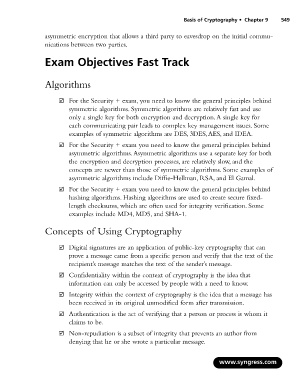Page 565 - StudyBook.pdf
P. 565
Basis of Cryptography • Chapter 9 549
asymmetric encryption that allows a third party to eavesdrop on the initial commu-
nications between two parties.
Exam Objectives Fast Track
Algorithms
For the Security + exam, you need to know the general principles behind
symmetric algorithms. Symmetric algorithms are relatively fast and use
only a single key for both encryption and decryption.A single key for
each communicating pair leads to complex key management issues. Some
examples of symmetric algorithms are DES, 3DES,AES, and IDEA.
For the Security + exam you need to know the general principles behind
asymmetric algorithms.Asymmetric algorithms use a separate key for both
the encryption and decryption processes, are relatively slow, and the
concepts are newer than those of symmetric algorithms. Some examples of
asymmetric algorithms include Diffie-Hellman, RSA, and El Gamal.
For the Security + exam you need to know the general principles behind
hashing algorithms. Hashing algorithms are used to create secure fixed-
length checksums, which are often used for integrity verification. Some
examples include MD4, MD5, and SHA-1.
Concepts of Using Cryptography
Digital signatures are an application of public-key cryptography that can
prove a message came from a specific person and verify that the text of the
recipient’s message matches the text of the sender’s message.
Confidentiality within the context of cryptography is the idea that
information can only be accessed by people with a need to know.
Integrity within the context of cryptography is the idea that a message has
been received in its original unmodified form after transmission.
Authentication is the act of verifying that a person or process is whom it
claims to be.
Non-repudiation is a subset of integrity that prevents an author from
denying that he or she wrote a particular message.
www.syngress.com

